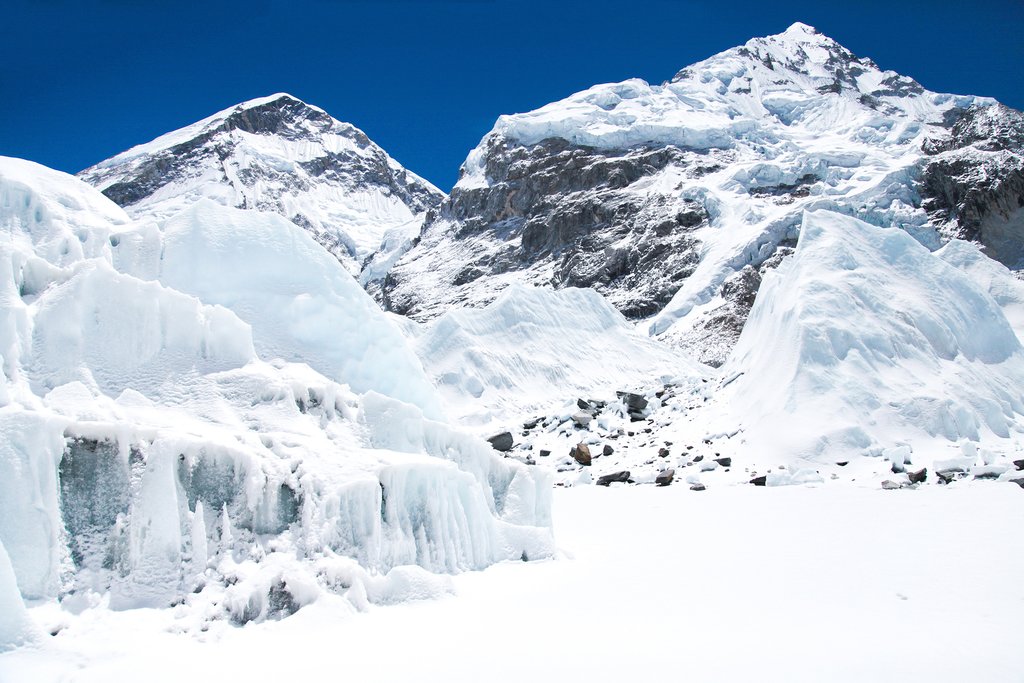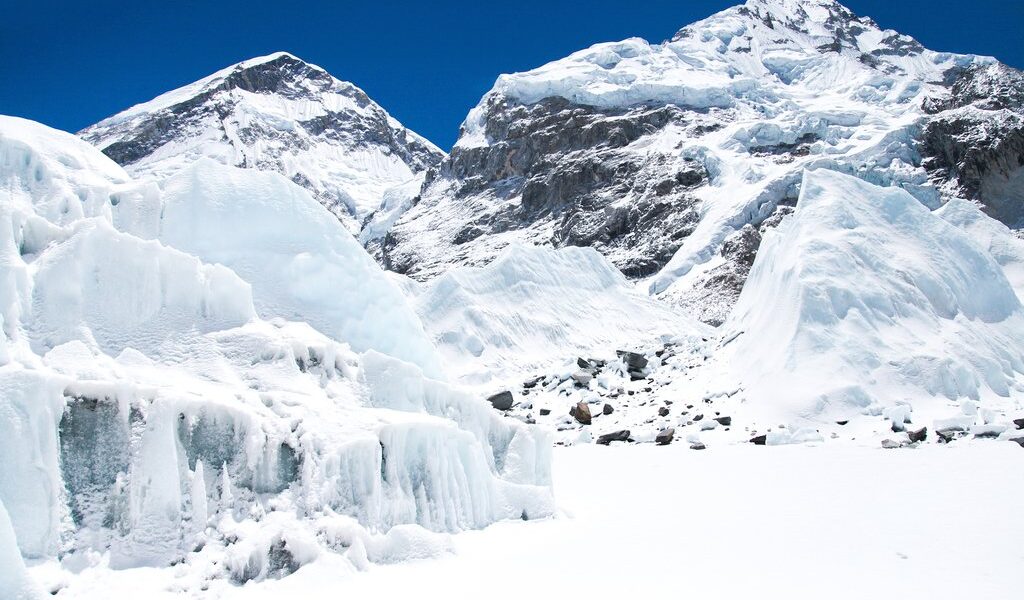
February continues the off-season for trekking in Nepal, with colder temperatures hanging around and fewer visitors throughout the country. If you’re very well prepared for snow and cold temperatures, the clear views and quiet trails make February an appealing time to trek in the Everest region—and even all the way to Everest Base Camp.
Weather
While the initial days of February often maintain the chill that characterizes winter throughout much of Nepal, a noticeable shift occurs as the month progresses. The sun begins to assert its presence, and the mercury gradually rises. In the high mountain regions, however, temperatures remain decidedly low, and the snow, which blankets the landscape, tends to linger. Winter’s icy grip loosens, but its presence is still felt. Imagine the majestic peaks, capped with snow, gradually yielding to the warming sun. Even so, be prepared for cold conditions.
Consider, for example, the climate in Namche Bazaar (11,290 feet/3440 meters). The average temperature in February hovers around 43°F (6°C). While this isn’t frigid, it certainly doesn’t qualify as warm. You’ll want to pack accordingly to ensure comfort.
If your trekking adventure is scheduled for later in February, you might be pleasantly surprised by the occurrence of some remarkably pleasant days. The sun’s rays become stronger, and the air feels crisper. These pockets of warmer weather can make your journey particularly enjoyable. Furthermore, the skies are generally clear during this time, offering breathtaking, unobstructed views of the mountains. Humidity is typically low, ensuring that the stunning panoramas remain sharp and vivid.
Crowds & Costs
February falls firmly within the low season for trekking in the Everest region. This translates to a greater availability of accommodation in the teahouses that remain open along the popular Everest Base Camp trail and throughout the broader Everest region. It is wise to note, however, that some teahouses close their doors for the winter months. This means that your selection of accommodation options may be somewhat limited compared to the choices available during the peak trekking seasons of spring and autumn. When these months hit, the trails and accomodations are booming.
A knowledgeable guide can be an invaluable asset in navigating these conditions. Your guide will be familiar with which establishments are open and will be able to secure appropriate accommodation for you, ensuring that you have a comfortable and safe place to rest each night.
Similar to January, trekking in February often presents better value for money than trekking during the bustling peak season. Flights to Lukla, the gateway to the Everest region, are less likely to be fully booked, giving you a wider array of flight times to choose from. This flexibility can be a significant advantage, allowing you to tailor your travel schedule to your specific needs and preferences.
Moreover, the accommodation that remains open during February is more likely to offer favorable rates. You stand a greater chance of securing a good room at a reasonable price compared to the peak season, when demand is high and prices tend to surge. Take advantage of this opportunity to enjoy a more budget-friendly trekking experience.
The trails in the Everest region are significantly less crowded in February compared to the peak months of October and April. This quieter atmosphere translates to a more serene and intimate trekking experience. You won’t have to contend with hordes of other trekkers, which means no random strangers photobombing your cherished mountain photos. The view points are less congested. There’s less jostling for space at viewpoints, allowing you to fully savor the breathtaking vistas.
Imagine having those magnificent, unobstructed views almost entirely to yourself. This is a rare and precious opportunity that enhances the overall sense of adventure and immersion in the stunning natural surroundings. Considering that EBC (Everest Base Camp) is Nepal’s most popular and, consequently, most crowded trek, choosing to embark on this journey during the low season has the potential to dramatically transform your experience, making it more peaceful, personal, and unforgettable.
Recommended Routes
Certain higher-elevation treks are generally not recommended in February due to the combination of frigid temperatures and substantial snowfall. Treks that involve crossing high mountain passes, such as the challenging Three Passes Trek, are particularly susceptible to being snowbound during this time. While snow accumulation can sometimes occur even during the more popular trekking months, the likelihood is significantly higher in February. Consider the conditions to stay safe and comfortable.
Treks that remain below an altitude of approximately 13,000 feet are generally considered to be more comfortable and safer to undertake in February. However, even on these lower-altitude routes, it is absolutely essential to diligently monitor (or have your guide monitor) the prevailing weather conditions as you progress along your trek. Be prepared to turn back or discontinue your trek at any point if the weather takes a turn for the worse. Safety should always be your top priority.
Unless you possess extensive experience in trekking in cold temperatures and at high altitudes, it might be prudent to consider an alternative to the full EBC trek. Instead, opt for a shorter trek within the Everest region that does not ascend all the way to Base Camp. This allows you to enjoy the beauty of the region without the added challenges posed by extreme conditions. Namche Bazaar is a charming Sherpa town that is located approximately two days’ walk from Lukla. By establishing a base in Namche Bazaar, you can embark on a variety of day hikes in the surrounding area. Consider this location as your base of operations to travel outwards and back in.
You could even undertake some overnight trips if the prevailing weather conditions are favorable. This flexibility allows you to adapt your itinerary to the actual circumstances on the ground. The views from Namche Bazaar and its environs are likely to be spectacular during this time of year. You’re also less likely to encounter altitude-related or temperature-related problems at the lower elevation of Namche Bazaar.
One significant advantage of trekking during the less-congested low season is the freedom to make spontaneous decisions about taking overnight trips from Namche Bazaar. You won’t be constrained by the need to book lodging far in advance. This flexibility adds a sense of spontaneity and adventure to your trek.
The ‘Pioneers’ Route’ trek, which stretches from Jiri to Lukla, also presents a compelling option for a February trek. This route earned its name because it was the very trail that early Western mountaineers traversed to gain access to the Everest region, long before the construction of the airport at Lukla. Embark on the path of those who came before you. Jiri is located approximately a day’s drive away from Kathmandu.
Alternatively, you could choose to fly from Kathmandu to Phaplu and then trek through the scenic Solukhumbu region from there. In recent years, fewer trekkers have ventured through the Solukhumbu region, preferring instead to focus on the higher-altitude Khumbu region. However, those who do choose to explore the Solukhumbu are rewarded with the discovery of a fascinating culture that stands in contrast to the Tibetan Buddhist Sherpa culture prevalent at higher altitudes. These treks typically range in duration from 4 to 7 days, depending on the specific route you select.
From Lukla, you have the option to continue onward to Namche Bazaar and establish a base there for a series of day hikes, as previously mentioned. This allows you to experience the best of both regions, combining the cultural immersion of the Solukhumbu with the stunning mountain scenery around Namche Bazaar.
February is also an ideal time to indulge in a luxurious tour of the Everest region. Travelers who have a bit more financial flexibility will undoubtedly appreciate the opportunity to stay in some of the Everest region’s finest lodges. These can be combined with helicopter transfers for one or both legs of your journey, providing an unforgettable and breathtaking experience. Soar over the landscape in style. While this type of trip is special at any time of year, it becomes even more extraordinary in winter, when you can retreat from the cold and find refuge in a cozy, boutique hotel nestled in the heart of the mountains.
Imagine yourself sipping hot tea by a crackling fire, surrounded by stunning mountain views, after a day of exploring the winter wonderland. The perfect way to relax and rejuvenate after your adventure.
What to Bring
It is absolutely essential to be thoroughly prepared for the cold weather conditions that prevail in February. This preparation is crucial not only for your comfort but also for your safety. Although many teahouses provide blankets for their guests, these may not always be sufficient to provide adequate warmth in winter conditions. Therefore, it is highly recommended that you supplement these with your own warm bedding. A sleeping bag specifically designed to keep you warm in temperatures as low as -22°F (-33°C) is an ideal choice. This will ensure a comfortable and safe night’s sleep.
While the sun can provide some welcome warmth during the day, it is important to remember that at higher altitudes, you will still need to trek in warm clothing. A warm down jacket is an excellent choice, as it provides exceptional insulation while remaining lightweight and packable. Warm clothing for the evenings and nights is also essential, as temperatures can plummet rapidly after sunset. Don’t forget to pack good woolen hats, gloves, socks, and scarves to protect yourself from the cold.
Almost all of the winter equipment you might need can be readily purchased or rented at the numerous trekking shops located in Thamel, Kathmandu. This is a convenient option if you don’t own your own winter trekking gear and don’t anticipate needing it at home. This bustling neighborhood offers a wide selection of gear to choose from. You’re sure to find what you need.
Getting There & Away
The most expeditious method of reaching the Everest region at any time of year is to take a flight from Kathmandu to Lukla. While the likelihood of rain causing delays and cancellations is lower in February compared to some other months, Kathmandu is prone to experiencing fog during the winter season, although this is less frequent later in February. This fog has the potential to disrupt flights to or from Lukla, even if the weather conditions in the mountains are otherwise favorable. It is essential to factor in this potential for delays when planning your travel arrangements.
Monitor the weather forecast closely and be prepared for possible adjustments to your flight schedule.
Events in February
The inhabitants of the Everest region primarily belong to the Sherpa community and adhere to the tenets of Tibetan Buddhism. Consequently, they typically do not celebrate the same festivals as the Hindu Nepalis who reside in Kathmandu and other hill areas. However, February is often a month rich in festivals in Kathmandu and various other parts of Nepal. Maha Shivaratri, a significant Hindu festival dedicated to Lord Shiva, and Holi, the vibrant festival of spring, often take place in late February (and occasionally in early March). While you are unlikely to witness these festivals being celebrated within the Everest region itself, if your trip to Nepal coincides with these festive occasions, you can certainly partake in the celebrations in Kathmandu either before or after your trek. This provides a wonderful opportunity to immerse yourself in the local culture and experience the vibrancy of Nepali traditions.
Our Favorite Itineraries in February
Best Winter Treks in Nepal
Everest Luxury Heli Trek – 4 Days
Namche Bazaar Trek – 7 Days
Tengboche Monastery Trek – 10 Days
Dingboche Trek – 12 Days
More Helpful Information
Everest Base Camp in January
Everest Base Camp in March
Nepal in February
Domestic Flights in Nepal
B-1717

